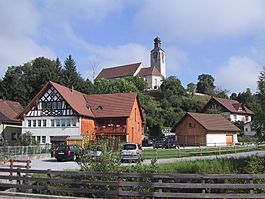Zuzwil, St. Gallen facts for kids
Quick facts for kids
Zuzwil
|
||
|---|---|---|
 |
||
|
||
| Country | Switzerland | |
| Canton | St. Gallen | |
| District | Wil | |
| Area | ||
| • Total | 8.97 km2 (3.46 sq mi) | |
| Elevation | 550 m (1,800 ft) | |
| Population
(Dec 2020 )
|
||
| • Total | 4,786 | |
| • Density | 533.6/km2 (1,381.9/sq mi) | |
| Postal code |
9524
|
|
| Surrounded by | Bronschhofen, Niederhelfenschwil, Oberbüren, Uzwil, Wil, Wuppenau (TG) | |
Zuzwil (SG) is a village and a municipality in the canton of St. Gallen in Switzerland. It is part of the Wil area.
Contents
Geography of Zuzwil
Zuzwil covers an area of about 9 square kilometers (3.5 square miles). A big part of this land, almost 59%, is used for farming. Forests cover about 24% of the area. The rest of the land, about 17%, has buildings and roads. Only a tiny bit, less than 1%, is made up of rivers or lakes.
The town is located at the bottom of the northern Alps mountains. It's in a region called "Fürstenland," just east of the old city of Wil. To the north, you'll see wooded hills. The Thur River flows along the southern edge of the town. Because of its location facing south, Zuzwil offers amazing views of the eastern Swiss Alps, especially the Alpstein mountains.
The Municipality of Zuzwil includes three main areas: Zuzwil, Züberwangen, and Weiern.
Weiern Village
Weiern is a small village that became part of the Zuzwil municipality in 1803. This happened when the Canton of St. Gallen was officially created.
Züberwangen Village
Züberwangen was first mentioned in an old document called the Henauer Urkunde in 754. Like Weiern, it joined the Zuzwil municipality when the Canton of St. Gallen was formed in 1803.
History of Zuzwil
The area where Zuzwil is today was settled by the Alamanni. They were a Germanic tribe who arrived about 1,500 years ago. Before the Alamanni, the region was ruled by the Romans and had very few people living there. Even earlier, Celtic peoples lived in this region.
The village of Züberwangen was first written about in the Henauer Urkunde (Deed of Henau) in the year 754. This document talks about land in Züberwangen and other small villages that belonged to a man named Rotphald. He gave this land to the Abbey of St. Gall.
Zuzwil itself is first mentioned in a different document from May 11, 761. This document also describes land in Zuzwil being given to the Abbey of St. Gall.
The original name for Zuzwil was “Zuocewilare” or “Zuozo Vilare.” This means “Zuozo's hamlet.” People believe the name came from an Alamanni clan leader named “Zuozo” who started a settlement there.
Zuzwil's Coat of Arms
The blazon (description) of Zuzwil's coat of arms is: Gules two Lions passant Argent. This means it shows two silver lions walking across a red background.
People and Population (Demographics)
Zuzwil has a population of about 5,000 people. As of 2007, about 10.3% of the people living in Zuzwil were from other countries. Many of these foreign residents came from Germany, Italy, or former Yugoslavia.
Most people in Zuzwil speak German, which is about 93.6% of the population. Other languages spoken include Albanian and Serbo-Croatian.
Looking at the age of people in Zuzwil (as of 2000):
- About 15.6% of the population were children aged 0 to 9 years old.
- About 15.1% were teenagers aged 10 to 19 years old.
- About 18.0% were adults aged 30 to 39.
- About 12.8% were adults aged 50 to 59.
- About 5.7% were seniors aged 60 to 69.
In 2000, about 7.6% of people lived alone. Many people, about 64.6%, lived in families with children.
In the 2007 federal election, the most popular political party was the SVP. They received almost 39% of the votes. Other popular parties were the CVP and the FDP.
Many adults in Zuzwil have a good education. About 80.4% of people aged 25–64 have finished high school or gone on to higher education, like a university.
Economy of Zuzwil
Zuzwil has a low unemployment rate, which was 1.75% in 2007. The economy is divided into three main parts:
- Primary sector: This involves farming and natural resources. In 2005, about 103 people worked in this area.
- Secondary sector: This includes manufacturing and industry. About 606 people worked in this sector.
- Tertiary sector: This covers services, like shops, offices, and healthcare. About 704 people worked in this sector.
Many people who live in Zuzwil also work there. However, a lot of residents travel outside Zuzwil for their jobs. Also, many people come into Zuzwil from other places to work.
Religion in Zuzwil
According to the 2000 census, most people in Zuzwil are Roman Catholic, making up about 61.1% of the population. The next largest group, about 24.4%, belongs to the Swiss Reformed Church.
There are also smaller groups of people who belong to other Christian churches, including the Orthodox Church. About 2.79% of the population are Islamic. Some people, about 6.56%, do not belong to any church or have no specific religion.
Error: no page names specified (help). In Spanish: Zuzwil (San Galo) para niños
In Spanish: Zuzwil (San Galo) para niños






